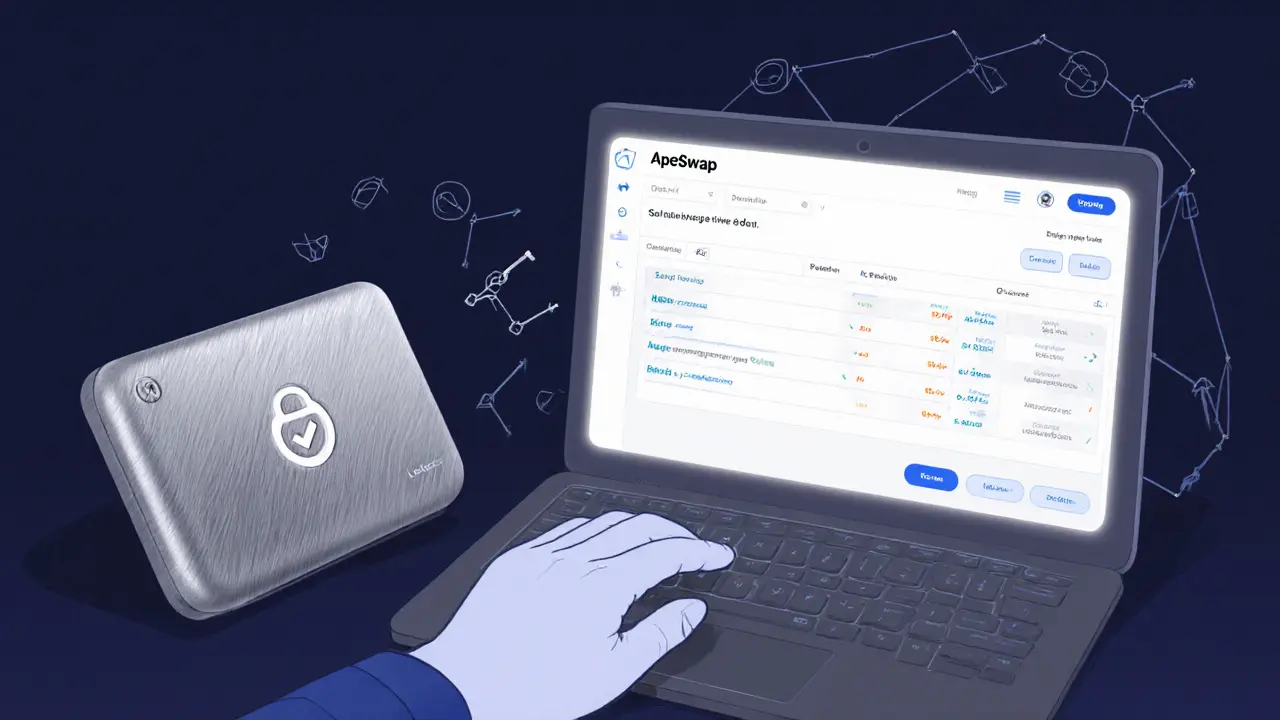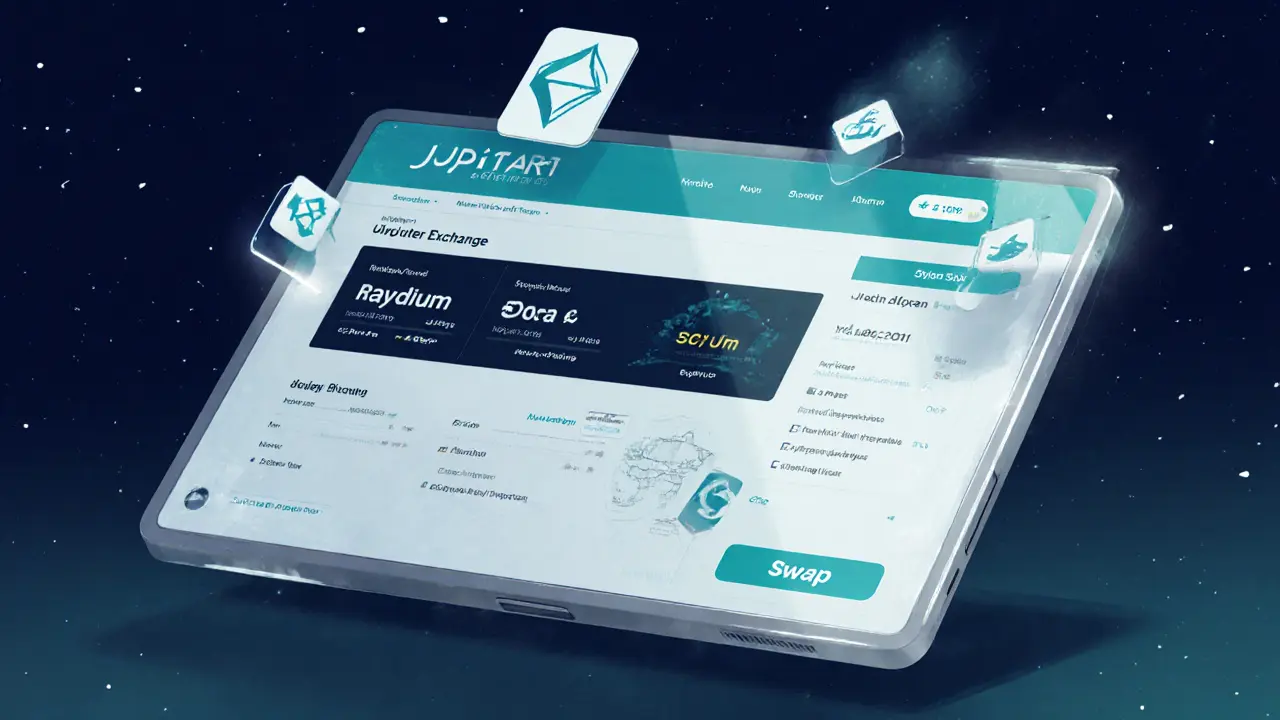ApeSwap (Polygon) Review: Is This Multichain DEX Worth Your Trade?

ApeSwap Trading Fee Calculator
Trade Details
Trading Cost Analysis
- 0.3% swap fee (goes to liquidity providers)
- Network fee: <$0.01
- Slippage: 0%
When you hear the name ApeSwap is a multichain decentralized exchange (DEX) that combines automated market making with a built‑in NFT marketplace, you probably wonder if it can hold its own against the giants like Uniswap or PancakeSwap. This review focuses on the Polygon deployment - the network that promises cheap, fast transactions - and breaks down what you really get, how the numbers stack up, and whether the platform fits a typical crypto‑trader’s workflow.
Key Takeaways
- ApeSwap runs on Polygon, Binance Smart Chain and Ethereum, but Polygon’s 24‑hour volume sits under $5,000, indicating early‑stage adoption.
- The platform offers swapping, yield farming, staking and an NFT marketplace without leaving the app.
- Security‑focused integrations include Ledger, Trezor and WalletConnect, but no public audit reports are linked.
- Ranking (#590 overall, #120 in swaps) places ApeSwap in the middle of the DEX pack - not a market leader but solid for multichain users.
- Fees are comparable to other AMM DEXs; however, lower liquidity on Polygon can raise slippage for larger trades.
What ApeSwap Is and How It Works
At its core, ApeSwap operates as an automated market maker (AMM) that lets you trade directly from your wallet. Instead of an order book, the protocol relies on liquidity pools where users deposit token pairs. When you swap, the smart contract pulls the needed amount from the pool, applying a constant‑product formula (x×y=k) to keep prices balanced.
The platform’s Polygon layer‑2 solution for Ethereum offers sub‑$0.01 transaction fees and sub‑second finality, making it attractive for small‑scale traders who hate high gas costs on Ethereum. ApeSwap also mirrors the same AMM logic on Binance Smart Chain a high‑throughput EVM‑compatible chain and Ethereum the original home of DeFi, so you can jump between networks without switching wallets.
Feature Set Beyond Simple Swaps
What makes ApeSwap feel more like a DeFi hub than a bare‑bones DEX?
- Yield Farming: Users can lock LP tokens into farms that distribute native $BANANA rewards. Some farms pair $BANANA with other tokens for “dual‑reward” schemes.
- Staking: The platform offers a single‑sided staking vault where you deposit $BANANA to earn additional yields.
- NFT Marketplace: A dedicated tab lets creators list NFTs, and collectors can buy them using MATIC or stablecoins, blending trading and collectibles.
- API & Integration: Developers can tap into the ApeSwap API for price data or embed swap widgets. Existing integrations include 1inch a DEX aggregator that routes orders for best price, Ledger, Trezor, and WalletConnect a bridge for mobile wallets.
Performance on Polygon - Numbers That Matter
According to the latest on‑chain data, the Polygon instance of ApeSwap recorded a 24‑hour trading volume of $4,899.20. While that looks modest next to PancakeSwap’s hundreds of millions, it reflects the still‑growing user base on Polygon for AMM DEXs.
Liquidity depth is another practical metric. The most liquid pair, MATIC/USDC, typically holds around $150k in the pool. For a trader moving $5k, slippage hovers near 2‑3%. Larger swaps (> $10k) can see slippage spike above 5%, which may deter institutional users.
Ranking data from Coinbase places ApeSwap at #590 among all dApps and #120 in the “swap” category. This positioning signals decent visibility but also room for growth.

How It Stacks Up Against the Competition
| Aspect | ApeSwap | Uniswap | PancakeSwap |
|---|---|---|---|
| Supported Chains | Polygon, BNB Chain, Ethereum | Ethereum, Polygon (via bridge) | BNB Chain, Polygon (via bridge) |
| 24h Volume (Polygon) | $4.9k | ≈ $1.2M | ≈ $800k |
| Liquidity (Top Pair) | $150k | $12M | $7M |
| Extra Features | Yield farms, staking, NFT marketplace | Basic swaps, limited farms | Farms, lottery, launchpad, NFT marketplace |
| Ranking (Swap category) | #120 | #15 | #30 |
In short, ApeSwap lags behind Uniswap and PancakeSwap on raw liquidity and volume, but it makes up for that with a broader feature set and true multichain accessibility. If you value a single UI for swapping, farming and NFTs, ApeSwap can be a convenient hub.
Security and Trust Considerations
The platform supports hardware wallets - Ledger and Trezor - giving heavy‑weight users a safer signing path. However, the public audit status is a gray area; the team has not posted a recent audit report on their docs page. That doesn’t automatically mean it’s unsafe, but it’s a red flag for risk‑averse investors.
Since ApeSwap is a decentralized protocol, there’s no central authority to freeze assets, which aligns with DeFi’s ethos but also means you’re fully responsible for private‑key safety and compliance with local regulations. In New Zealand, the Financial Markets Authority treats DEXs as unregulated, so users must handle tax reporting themselves.
Pros, Cons, and Who Should Use It
- Pros
- All‑in‑one DeFi hub (swap, farm, stake, NFTs).
- Low fees on Polygon.
- Cross‑chain compatibility reduces the need for multiple wallets.
- Hardware‑wallet integration for extra security.
- Cons
- Relatively low liquidity on Polygon leads to higher slippage.
- No recent public security audit available.
- Smaller community means fewer third‑party tools and guides.
- Ideal Users
- Crypto hobbyists who want to experiment with farming and NFTs without hopping between sites.
- Traders on a budget who need cheap Polygon transactions.
- Developers looking for a multichain swap API.
How to Get Started on ApeSwap (Polygon)
- Install a Web3‑compatible wallet (MetaMask, Trust Wallet, or a hardware wallet via Ledger/Trezor).
- Switch the network to Polygon (you may need to add the RPC URL if it’s not preset).
- Visit apeswap.finance and click the “Connect Wallet” button.
- Approve the token you want to swap; the UI will show the estimated slippage and fees.
- If you’re interested in farming, navigate to the “Farms” tab, select a pool, and stake your LP tokens.
- For NFTs, go to the “Marketplace” section, browse collections, and complete purchases using MATIC or stablecoins.
All actions happen on‑chain; there’s no KYC, and you retain full control of your private keys.
Next Steps & Troubleshooting
If you hit a high slippage error, try the following:
- Reduce the trade size or split it into multiple smaller swaps.
- Switch to a higher‑liquidity pair (e.g., MATIC/USDC) as a bridge token.
- Confirm you’re on the Polygon network; accidentally using BNB Chain will invoke a different fee structure.
Transaction failures can also stem from low gas limits. Polygon’s default gas is cheap, but you still need to set a minimum of 21,000units for simple swaps.

Frequently Asked Questions
Is ApeSwap safe to use on Polygon?
ApeSwap implements standard AMM contracts that have been audited in the past, and it supports hardware wallets. However, the platform has not published a recent third‑party security audit, so users should start with small amounts and keep private keys secure.
Why is the trading volume on Polygon so low?
Polygon’s DeFi ecosystem is still catching up to Ethereum and BNB Chain. ApeSwap’s focus on a multichain experience spreads its users across three networks, which dilutes the Polygon‑only volume. Expect growth as more projects launch on Polygon.
How do I claim $BANANA rewards from farming?
After staking your LP tokens in a farm, navigate to the “Harvest” button on the farm’s page. Click it to withdraw the accrued $BANANA into your wallet. You can then restake or swap the tokens.
Can I use ApeSwap with a Ledger device?
Yes. Connect your Ledger, open the Ethereum app (which also supports Polygon), and select it as the signing method when you click “Connect Wallet” on ApeSwap.
What are the fees for swapping on Polygon?
ApeSwap charges a 0.3% swap fee that goes to liquidity providers. Polygon’s network fee is usually less than $0.01 per transaction, making total costs negligible for most retail traders.



karsten wall
May 20, 2025 AT 13:01Alright, let’s break this down. ApeSwap’s multichain approach is cool because it reduces friction for users who hop between Polygon, BNB Chain, and Ethereum. The 0.3% fee is par for the course, but the ultra‑low network fees on Polygon make it attractive for micro‑trades. Liquidity on Polygon is still thin, so you’ll see higher slippage on larger swaps – a classic trade‑off in AMM design. The added NFT marketplace does give it a unique positioning, though most power users might still gravitate toward Uniswap or PancakeSwap for pure depth. Overall, if you’re comfortable with the modest liquidity, it’s a decent all‑in‑one hub.
Keith Cotterill
May 21, 2025 AT 05:41One must first acknowledge the ontological premise behind any decentralized exchange: it is an embodiment of the libertarian ethos, a manifestation of trustless protocols, and a crucible for liquidity provision. Yet ApeSwap, in its present iteration, seems to be caught in a liminal space between nascent promise and operational mediocrity; its volume on Polygon hovers under five thousand dollars, which, in the grand schema of DeFi, is akin to a whisper in a thunderstorm. The 0.3% swap fee, while industry‑standard, does little to offset the palpable risk introduced by the paucity of deep pools; slippage escalates precipitously beyond the $5,000 threshold, undermining the very cost‑efficiency that Polygon touts.
Moreover, the absence of a publicly audited smart‑contract audit report is not merely an oversight – it is an epistemic vacuum that erodes confidence among risk‑averse participants. The platform does proffer an NFT marketplace and yield farms, but these ancillary features are, at best, peripheral embellishments on a framework whose core is still under‑served. In juxtaposition with Uniswap’s $12M top‑pair liquidity on Polygon, ApeSwap’s $150k is a mere drop in the ocean, a fact that cannot be ignored by sophisticated traders.
From a macro‑economic perspective, the multichain ambition is commendable, yet execution lags; users must juggle three distinct networks, each with its own idiosyncrasies, potentially fracturing the user experience. The integration of hardware wallets such as Ledger and Trezor is a redemption point, but it does not compensate for the systemic liquidity deficit.
In summation, while the platform’s vision aligns with the progressive trajectory of DeFi, its current state is best suited for hobbyists willing to experiment with modest sums, not for capital‑intensive strategies. Proceed with caution, and consider diversifying across more liquid venues before allocating significant capital to ApeSwap.
C Brown
May 21, 2025 AT 14:01Wow, look at that academic rave – guess we’ve got a philosophy major crushing the DEX. Sure, ApeSwap’s got all the shiny bells and whistles, but if you can’t swap your ten‑grand without watching the slippage chart look like a heart‑monitor, what’s the point? It’s like bragging you have a sports car that only runs on Tuesdays. The NFT marketplace? Probably just a side hustle for the devs. Bottom line: it’s okay for a quick snack swap, but don’t expect it to feed your financial diet.
Darrin Budzak
May 22, 2025 AT 06:41I’ve been poking around ApeSwap for a few weeks now, and the UI feels pretty smooth. The low fees on Polygon are a nice relief compared to Ethereum’s gas spikes. Still, the liquidity is modest, so I split larger trades into smaller chunks to keep slippage down. The farming options are decent if you’re looking to earn some $BANANA on the side. Overall, it’s a solid supplementary tool in my DeFi toolbox.
Latoya Jackman
May 22, 2025 AT 23:21The platform’s lack of a recent audit is concerning; I’d recommend starting with a tiny amount. Also, keep an eye on network fees – they can creep up if you’re not on Polygon.
mukund gakhreja
May 23, 2025 AT 07:41Ah, the ever‑vigilant safety police strikes again. Sure, let’s all panic because there’s no fresh audit – that’s the de‑fi equivalent of fearing a storm because the sky is cloudy. The reality is, many users have been swapping on ApeSwap without catastrophe. If you’re truly risk‑averse, stick to a hardware wallet and keep your trades modest; otherwise, you’ll waste time worrying instead of earning.
Lisa Strauss
May 24, 2025 AT 00:21Looks promising!
CJ Williams
May 24, 2025 AT 17:01Hey folks! 🙌 Just wanted to say I’ve been testing the ApeSwap farms and the yields look decent, especially when you stake $BANANA. The UI is user‑friendly, and the low Polygon fees are a real win. Remember to break up big swaps to keep slippage low – that’s the trick I use! Keep experimenting and have fun.
Eugene Myazin
May 25, 2025 AT 01:21Cool rundown! I agree, the fees are tiny on Polygon and the cross‑chain vibe is handy.
Megan King
May 25, 2025 AT 18:01Just started using ApeSwap for a couple of swaps and the experience is smooth. The low gas on Polygon makes it feel like a no‑brainer, and I liked how easy it was to hop into a farm without a ton of steps.
Rachel Kasdin
May 26, 2025 AT 10:41Yo, I’m all about that low‑fee game, but the liquidity on Polygon is kinda whack. Still, if you’re just flipping small amounts, it works. Just don’t expect it to handle a whale‑size trade without screaming slippage.
Nilesh Parghi
May 27, 2025 AT 03:21Interesting take on the platform’s trade‑off between fees and depth. It’s a classic DeFi balancing act – cheap transactions versus sufficient liquidity. If you can manage your trade size, ApeSwap can fit nicely into a diversified strategy.
Noel Lees
May 27, 2025 AT 11:41Totally agree! I’ve found splitting trades into sub‑chunks helps a lot – keeps the slippage in check and the fees stay minimal. Also, the NFT marketplace adds a fun twist if you’re into collectibles. 🚀
Raphael Tomasetti
May 28, 2025 AT 04:21ApeSwap’s multichain design offers interoperability, but the Polygon liquidity pool size remains a bottleneck for high‑volume traders.
Jenny Simpson
May 28, 2025 AT 12:41Well, isn’t that just the epitome of over‑promising and under‑delivering? You’re sold on the idea of a “one‑stop‑shop” but then hit the wall of shallow pools. It’s a classic case of hype eclipsing substance – a dramatic, yet predictable, showdown.
Raj Dixit
May 29, 2025 AT 05:21Short answer: good for tiny swaps, not for big money.
Andrew McDonald
May 29, 2025 AT 13:41Interesting point, but let’s not forget that the lack of a recent audit is a glaring red flag. 🙄 It’s wise to stay cautious.
Adeoye Emmanuel
May 30, 2025 AT 06:21Hey all, I’ve been digging into the cross‑chain capabilities and they’re pretty slick. The biggest challenge remains the thin liquidity on Polygon, but for experimental trades and learning, it’s a solid playground. Keep testing, keep sharing insights!
Sabrina Qureshi
May 30, 2025 AT 14:41Wow!!! The fees are super low!!! But the liquidity? OMG, it’s like trying to pour water into a desert!!! 😭
Rahul Dixit
May 31, 2025 AT 07:21Honestly, the whole multichain hype feels like a distraction. Keep an eye on the hidden risks, especially when the platform’s audit history is vague. If you’re not ready to question the narrative, you’ll end up overexposed.
Michael Ross
May 31, 2025 AT 15:41I think a balanced approach works best – use ApeSwap for small, cheap swaps and switch to bigger DEXes for larger positions.
Deepak Chauhan
June 1, 2025 AT 08:21Esteemed community, one must consider the epistemic framework underpinning ApeSwap’s architecture: while the protocol exhibits commendable modularity, the empirical data suggests a liquidity constraint on Polygon that may impair execution fidelity for sizable transactions. In practice, a judicious user might allocate modest capital to ApeSwap whilst diversifying exposure across higher‑depth venues. 📚